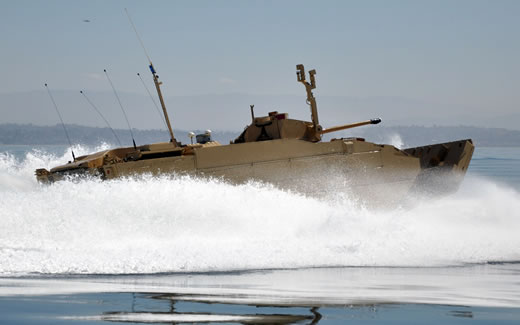
Defense Secretary Robert Gates is recommending to cancel the procurement of the Marine Corps $15 billion amphibious ‘Expeditionary Fighting Vehicle’ (EFV) program. After spending $3 billion in the development of this vehicle, the program is currently at a crossroad, transitioning into production, terminating it at this phase represent a ‘bargain’ to the bean counters, as everything spent on the program is sunk cost while future year-outlays are still minimal.


The EFV’s aggressive requirements list has resulted in an 80,000 pound armored vehicle that skims the surface of the ocean for long distances at high speeds before transitioning to combat operations on land. Meeting these demands has over the years led to significant technology problems, development delays, and cost increases. Gates mentioned that the EFV will cost about $12 billion to build – all for a fleet with the capacity to put 4,000 troops ashore. “If fully executed, the EFV – which costs far more to operate and maintain than its predecessor – would essentially swallow the entire Marine vehicle budget and most of its total procurement budget for the foreseeable future.” Secretary Gates warned.
Gates mentioned recent analysis by the Navy and Marine Corps suggests that the most plausible scenarios requiring power projection from the sea could be handled through a mix of existing air and sea systems employed in new ways along with new vehicles – scenarios that do not require the exquisite features of the EFV. “As with several other high end programs cancelled in recent years, the mounting cost of acquiring this specialized capability must be judged against other priorities and needs. ” said Gates. In 2009 Gates instructed the U.S. Army to cancel the Future Combat Systems’ program along with seven types of armored vehicles, destined to become the core of the Army’s Future Force.
“This decision does not call into question the Marine’s amphibious assault mission.” he added, “We will budget the funds necessary to develop a more affordable and sustainable amphibious tractor to provide the Marines a ship-to-shore capability into the future. The budget will also propose funds to upgrade the existing amphibious vehicle fleet with new engines, electronics, and armaments to ensure that the Marines will be able to conduct ship-to-shore missions until the next generation of systems is brought on line. It must be judged against other priorities and needs.”
Other land systems program cancellations mentioned in today’s briefing included the SLAMRAAM surface to air missile the Non-Line of Sight Launch System, both programs were already ‘announced dead’ several months ago.
The Army plans to use the available funds from these cuts to fund the modernize its M-1A2 Abrams tanks, Bradley Fighting Vehicles, and Stryker wheeled vehicles. The Army is also planning to accelerate fielding of a soldier level tactical communications network. The Navy will use part of the money to reset and repair Marine equipment returned from Iraq and Afghanistan.



















